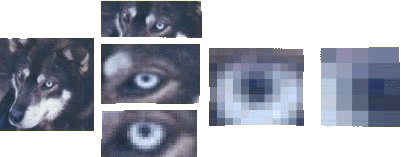On Connecting the Dots
Today, a cat helps me see how to connect the dots -- and make the picture whole. The University of Houston's College of Engineering presents this series about the machines that make our civilization run, and the people whose ingenuity created them.
I like pointillism -- Seurat's paintings, newspaper photos emerging from clouds of tiny black dots. But what happens when the whole fails to emerge, and we're left with only dots?
A librarian recently pointed out to me that some students using our rich electronic sources fall into a trap of unmerged dots. That's because the new computer search engines are powerful. They lead us only to the precise title or text we seek.
We no longer need to read the whole article or book to find what we want. We quit reading the nearby words in a dictionary. We've begun to lose context. If we let that happen, knowledge will become sterile. Serendipity will evaporate.
I knew what she meant. When I really set out to learn, I have to recognize relations among points in space. Even as I type pointillist letters into my computer, a cat twists in my lap. The sensate three-dimensional beast cranes his neck, sniffing the depth of the room. "Don't let your computer oversimplify the near-infinite reach of reality," he seems to say.
Twenty-two years ago I sat in an outdoor cafe with four colleagues. We wondered aloud whether or not we should let students use pocket calculators when they took tests. How would they ever learn to use their slide rules!
That sounds so foolish today. A few years later slide rules went the way of dinosaurs. As we sat in that cafe, their death was as certain as yours and mine, and it was far more imminent.
Now our worry doesn't look quite so silly. You had to do mental arithmetic when you used a slide rule. You had to place the decimal point in your head. You were given a mental picture of logarithmic, exponential, and trigonometric variations.
Our students today are smart, make no mistake. And they can work wonders with their computers. But they have far more trouble estimating numbers. They have trouble in a graphical world. As they're robbed of context, they have more and more trouble negotiating the empty space between the dots.
Still, there never was any real hope of keeping slide rules. And there can be no question that we have to fully and rapidly embrace the computer today. Our job as teachers is that of giving our students the multi-dimensional, multi-textured context they lost when they left slide rules and paper graphs behind.
When we're careless, we let computers give us only dots. Our job as engineers, teachers, information specialists, and human beings is to display the mosaic and connect the dots. It is to bring knowledge all the way back from the computer to sensate reality. The cat in my lap understands. And now -- so must I.
I'm John Lienhard, at the University of Houston, where we're interested in the way inventive minds work.
(Theme music)
The librarian in the text above was actually two people. Judy Myers, UH Library Administration, pointed out to me the fragmentation of learning that she'd noticed increasingly among users of our library's new computer tools. Pat Bozeman, Head of Special Collections, offered the argument that a loss of spatial understanding attends the heavy use of computers. The very specificity of much electronic information breaks up the complete picture that knowledge must eventually form. The digital watch, for example, shows us only the time of day -- right now. It divorces us from time's context, which is so eloquently displayed by the graphical analog clock face.
I introduce the word "pointillism" as a reminder that those mere collections of dots, or "factoids," rightly used, inevitably form whole pictures.

Image by Jeanne Newlon. With permission
" ... left with only dots?"
Riddle:
Take up a pencil and connect all nine dots below with four straight lines made without lifting your pencil from the paper:
